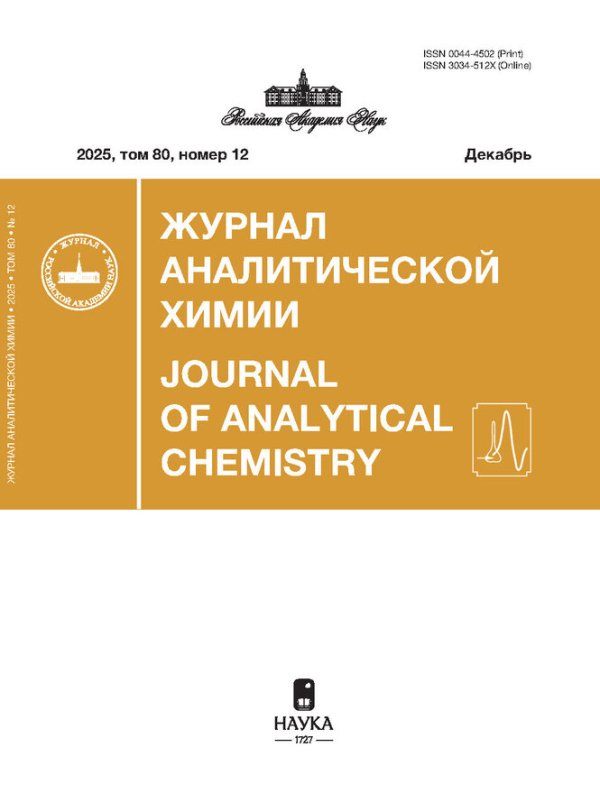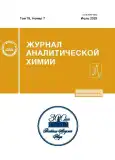Dispersive Liquid–Liquid Microextraction of Preservatives for Their Chromatographic Determination in Beverages
- Authors: Kochetkova M.A.1, Timofeeva I.I.1, Bulatov A.V.1
-
Affiliations:
- Institute of Chemistry, St. Petersburg State University
- Issue: Vol 78, No 7 (2023)
- Pages: 630-636
- Section: ORIGINAL ARTICLES
- Submitted: 14.10.2023
- URL: https://journals.rcsi.science/0044-4502/article/view/136052
- DOI: https://doi.org/10.31857/S0044450223070095
- EDN: https://elibrary.ru/VRYEUB
- ID: 136052
Cite item
Full Text
Abstract
A method of dispersive liquid–liquid microextraction, based on the dispersion of an extractant by the gas phase formed as a result of a phase transition, i.e., the evaporation of a highly volatile nonpolar organic solvent (dispersant) upon heating the extraction,—is developed. The analytical capabilities of the method are shown in the determination of preservatives (sorbic and benzoic acids) in soft drinks for baby food by high-performance liquid chromatography with photometric detection. The extractant and the dispersant for the microextraction of preservatives are chosen a terpenoid and a highly volatile organochlorine solvent, respectively, which excluded the use of polar organic solvents for dispersing phases, with which the distribution coefficients are reduced. The limits of detection (3σ) for sorbic and benzoic acids are 0.3 mg/L. The developed method does not require centrifugation for phase separation
About the authors
M. A. Kochetkova
Institute of Chemistry, St. Petersburg State University
Email: i.i.timofeeva@spbu.ru
198504, St. Petersburg, Russia
I. I. Timofeeva
Institute of Chemistry, St. Petersburg State University
Email: i.i.timofeeva@spbu.ru
198504, St. Petersburg, Russia
A. V. Bulatov
Institute of Chemistry, St. Petersburg State University
Author for correspondence.
Email: i.i.timofeeva@spbu.ru
198504, St. Petersburg, Russia
References
- Дмитриенко С.Г., Апяри В.В., Толмачева В.В., Горбунова М.В. Дисперсионная жидкостно-жидкостная микроэкстракция органических соединений. Обзор обзоров // Журн. аналит. химии. 2020. Т. 75. № 10. С. 867. (Dmitrienko S.G., Apyari V.V., Tolmacheva V.V., Gorbunova M.V. Dispersive liquid-liquid microextraction of organic compounds: An overview of reviews // J. Anal. Chem. 2020. V. 75. № 10. P. 1237.)
- Torbati M., Farajzadeh M.A., Torbati M., Afshar Mogaddam M.R. Development of solidification of floating organic drops liquid–liquid microextraction in new 2 designed extraction device for the extraction and preconcentration of organothiophosphate 3 pesticides from fruit juices and vegetable samples // New J. Chem. 2017. V. 41. P. 15384.
- Zgola-Grzeskowiak A., Grzeskowiak T. Dispersive liquid-liquid microextraction // Trends Anal. Chem. 2011. V. 30. P. 1382.
- Lemos V.A., Barreto J.A., Santos L.B., de Assis R.D.S., Novaes C.G., Cassella R.J. In-syringe dispersive liquid-liquid microextraction // Talanta. 2022. V. 238. Article 123002.
- Pochivalov A., Pavlova K., Garmonov S., Bulatov A. Behaviour of deep eutectic solvent based on terpenoid and long-chain alcohol during dispersive liquid-liquid microextraction: Determination of zearalenone in cereal samples // J. Mol. Liq. 2022. V. 366. Article 120231.
- Barbayanov K., Timofeeva I., Bulatov A. An effervescence-assisted dispersive liquid-liquid microextraction based on three-component deep eutectic solvent for the determination of fluoroquinolones in foods // Talanta. 2022. V. 250. Article 123709.
- Grau J., Azorin C., Benede J.L., Chisvert A., Salvador A. Use of green alternative solvents in dispersive liquid-liquid microextraction: A review // J. Sep. Sci. 2021. V. 45. P. 210.
- Waters K.L., Beal G.D. Some physical and chemical properties of commercial racemic menthol // J. Am. Pharm. Assoc. 1945. V. 34. P. 52.
- McDonagh J.L., Van Mourik T., Mitchell J.B.O. Predicting melting points of organic molecules: Applications to aqueous solubility prediction using the general solubility equation // Mol. Inform. 2015. V. 34. P. 715.
- Farajzadeh M.A., Goushjuii L. Study of menthol as a green extractant in dispersive liquid–liquid microextraction; application in extraction of phthalate esters from pharmaceutical products // Anal. Methods. 2013. V. 5. P. 1975.
- Witkowski M., Grajeta H., Gomulka K. Hypersensitivity reactions to food additives – Preservatives, antioxidants, flavor enhancers // Int. J. Environ. Res. Public Health. 2022. V. 19. P. 11493.
- ТР ТС 021/2011. О безопасности пищевой продукции.
- Yang N. Dichloromethane / Encyclopedia of Toxicology / Ed. Wexler P. Elsiver, 2014. P. 99.
- Tiecco M., Grillo A., Mosconi E., Kaiser W., Del Giacco T., Germani R. Advances in the development of novel green liquids: Thymol/water, thymol/urea and thymol/phenylacetic acid as innovative hydrophobic natural deep eutectic solvents // J. Mol. Liq. 2022. V. 364. Article 120043.
- Dzieciol M., Wodnicka A., Huzar E. Determination of benzoic and sorbic acids in foods // Ecol. Chem. Eng. A. 2012. V. 19. P. 451.
- Дмитриенко С.Г., Апяри В.В., Горбунова М.В., Толмачева В.В., Золотов Ю.А. Гомогенная жидкостная микроэкстракция органических соединений // Журн. аналит. химии. 2020. Т. 75. № 11. С. 963. (Dmitrienko S.G., Apyari V.V., Gorbunova M.V., Tolmacheva V.V., Zolotov Y.A. Homogeneous liquid-liquid microextraction of organic compounds // J. Anal. Chem. 2020. V. 75. № 11. P. 1371.)
- ТР ТС 029/2012. Требования безопасности пищевых добавок, ароматизаторов и технологических вспомогательных средств.
Supplementary files














